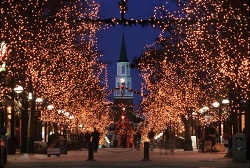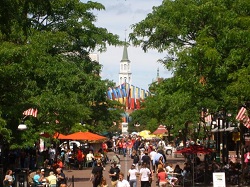Church Street Marketplace
Burlington, Vermont
Prepared by Ron Redmond, Executive Director, Church Street Marketplace.
Burlington, Vermont
Prepared by Ron Redmond, Executive Director, Church Street Marketplace.
The City of Burlington, Vermont, wanted to create a commercially viable center of pedestrian activity in the downtown area.
What began as a one-day experiment blossomed into one of the most successful and widely emulated urban pedestrian malls in the country. The redevelopment of the downtown area that eventually included the Church Street Marketplace began in the years of urban renewal projects in the 1950s and 1960s. Burlington, Vermont, sought to revitalize its downtown area during this time.

In January 1959, major urban renewal projects were approved for downtown Burlington and two through streets were permanently closed. In July 1970, the business community hosted a one-day street fair on Church Street to explore the feasibility of a multi-block, open-air pedestrian mall in the heart of the city. An estimated 15,000+ people took part in the day's festivities. A second midsummer street fair the following year was a full week long, entailed traffic rerouting, increased public transportation, and created outdoor retail displays, and temporary aesthetic enhancements on Church Street. The fair attracted 50,000 people downtown.
In 1976, Burlington received $1.6 million from the federal government for the construction of a 400-space parking garage near Church Street. Burlington was awarded design and planning money after being chosen as an auto-restricted zone demonstration site by the Urban Mass Transit Administration (UMTA), which is now called the Federal Transit Administration. The city turned down the funding, partly because stipulations attached to it would have required the city to repeat a significant portion of the planning that had already been completed. In a series of actions during 1978-1979, Burlington officials appealed to UMTA, the U.S. Environmental Protection Agency, Housing and Urban Development Agency, and Heritage Conservation and Recreation Service for financial support for a mall concept. The name "Church Street Marketplace" was chosen. U.S. Senator Patrick Leahy played an instrumental role in securing federal support for this project. A new, one-level mall design was unveiled and in May 1979, the Church Street Steering Committee applied to UMTA for a $5.4 million grant. The grant was awarded in June.
In a special election in August, city voters approved the creation of the Church Street Marketplace District and Commission, but failed by the slimmest of margins to pass a $1.5 million bond issue with the required two-thirds of the vote. The bond issue was needed to fund the city's share of the Marketplace construction costs. Acting on what appeared to be increasing public support, Mayor Paquette asked for another election and, in October, voters passed the bond issue with the required two-thirds majority. In 1980, the Church Street Marketplace Commission was formed in January. In March, the Marketplace Commission approved the final plans for Church Street.
Construction of the Church Street Marketplace pedestrian mall began. During 16 months of construction, which was completed in September 1981, not one business along Church Street moved or closed; retail sales in the area showed no decline.
Simultaneous with the startup of construction, CCTA bus routes through the city center were also rerouted.
The Church Street Marketplace opened in September, 1981, as a culmination of a 10-year collaborative effort between Burlington's business community, City Hall, city residents, and the State and national governments.

Some 200 outdoor pedestrian malls have been built in the U.S. since the late 1960s, yet only 30 or so remain in operation. One that not only has navigated the economic ups and downs of the past 27 years, but is considered the premier shopping and dining destination throughout Vermont, is Church Street Marketplace.
The product of an inclusive and careful planning and design process, Church Street Marketplace was one of American Planning Association's 2008 Great Public Spaces in America not only for the historic buildings, thriving retail trade, and carefully maintained streets and walkways, but also strong community support. Each year some 3 million visitors come to shop, eat, meet and greet, mark milestones, or just pass the time of day.
Church Street Marketplace is part of a National Register Historic District, with Victorian and Art Deco structures, and modern infill buildings. Building heights are restricted to preserve the appearance of historic structures while zoning promotes ground-floor retail and upper-story office and residential uses.
Fountains, public art, and locally quarried boulders enhance the streetscape. Street vendors and entertainers keep the atmosphere lively. In warm months, outdoor cafes are the perfect spot for people watching or conversing with friends. Festivals add excitement. The Magic Hat Mardi Gras Parade kicks things off in February, followed in June by the city's Discover Jazz Festival. On the day after Thanksgiving, Santa pays a visit from the North Pole; later that evening, more than 10,000 gather to watch the illumination of more than 200,000 white lights along the four-block-long Marketplace.
The Church Street Marketplace has been called "the gem in the crown" of Burlington. This four-block jewel in the heart of the city celebrated its 30th anniversary in 2011.
Both the Church Street Marketplace and the City of Burlington have consistently garnered nationwide acclaim for quality, both in the form of awards and of citations in national media. Burlington has been listed near the top of a wide range of "Top Ten Cities" lists in recent years -- and the community's vibrant downtown and its centerpiece pedestrian Marketplace are frequently cited for their essential roles in making Burlington distinctive.
From a pedestrian safety standpoint, the Church Street Marketplace is a pedestrian mall that has created a protected environment free from motor-vehicle traffic. Thus, pedestrian safety is greatly enhanced on Church Street. Also, to the extent that the pedestrian mall attracts pedestrians to use this street instead of parallel streets, the safety of those pedestrians would be greatly enhanced on the protected environment of the Church Street Pedestrian Mall, compared to conditions that they would encounter on those other traditional streets.
Ron Redmond, Executive Director
Church Street Marketplace
2 Church Street, Suite 2A
Burlington, Vermont 05401
Phone: 802-238-5598
Email: ron.redmond.vt@gmail.com